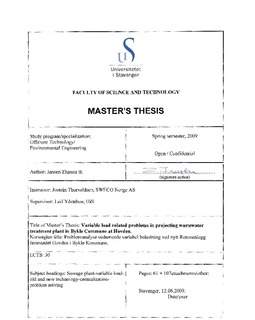Variable load related problems in projecting wastewater treatment plant in Bykle Commune at Hovden
Master thesis
Permanent lenke
http://hdl.handle.net/11250/182394Utgivelsesdato
2009Metadata
Vis full innførselSamlinger
Sammendrag
This paper is based upon the project of renewing of Waste Water Treatment plant in Bykle Commune in
Aust Agder, Norway.
It has been decided that it is necessary to build a new plant to meet the load as well as requirements for
treatment. The new plant is to be located in Hovden at the newly developed industrial area in the
southern part of the lake Hartevann.
The commune has decided to build a common plant for “Midregion” of the commune as well as Hovden.
The sewage from Hovden will have to be pumped to the Industrial are by means of a submerged pipe.
The fluid from the “Midregion” requires new sewage lines for transferring of the fluid over a distance of
18 km. with an elevation of 150m. utilizing pumping stations incorporating buffer and storage tanks.
The “Midregion” consists mainly of Vacation Homes where in vacation season the occupation is
approximately 70%. There are less than 50 permanent residences in the “Midregion”.
The “Midregion” does not today have common water supply but consists of private wells as well as small
pumping stations of water. In the NIVA Report from 2003[Ref.:App.E] it is mentioned that in some area is
not allowed for cabins to have an external water supply from private well or other source. The
Commune intends to link all residential homes and cabins with a water supply from Hovden waterworks.
The excavated ditch for the waterline will also contain the Sewage/fluid piping. The ditch has to be
excavated at a minimum of 18 km in variable geological conditions ranging from gravel, more to solid
rock.
Hovden and the “Midregion” are facing the same challenge of an extensive variation of load as is
common for all Vacation communities. The difficulty is evident when a small local population is to
maintain a properly functioning sewage plant that can within the framework of national requirements
meet the variation with proper cleaning.
This paper is setting out to clarify the variable load problem by looking at available technology as well as
assessing the communities’ decision of technology to be used. The paper further focuses on the
environmental as well as the economic impact and consequences of the communes’ final decision.
This paper further gives a conclusive advice to Bykle Commune in the aspects of plant and the economic
impact. For the matter of accuracy some reports used for this paper is presented in original in
Norwegian. The assessment papers are attaches as well as discussion with the communes’ consultant
from Sweco Norge AS.
The conclusion of this investigation and verification is that the “Midregion” should not be connected to
a common plant at the Industrial Area in Hovden. It is both Environmentally and Economic advisable to
build several Biodisk Sewage Plants using diffusion beds as receptacles for the effluent and letting the
Biotope Biologically perform the end task of cleaning without any outlet into rivers or lakes.
At the Hovden area it points itself out as the only solution both environmentally and economically to use
the BioBooster from Grundfos of Denmark. The BioBooster can handle the variable load as well as the
future expansion without large construction and unnecessary economic cost of concrete tank and
building. The BioBooster using a ultra filtration membrane gives a total cleaning result and a extremely
clean effluent. (See final paper “Hovden Renseanlegg. Kort Assessment. Report til Bykle
Kommune.” and Disscussion [Ref.: App.I])
Beskrivelse
Master's thesis in Environmental technology
